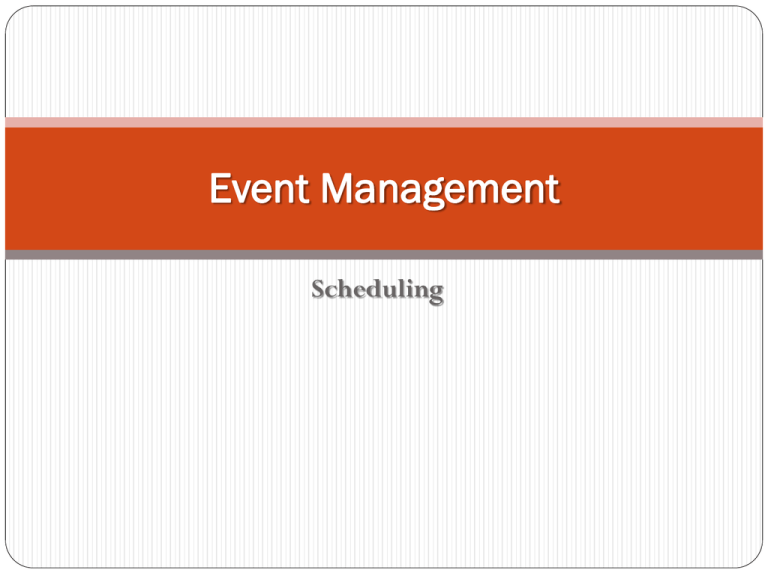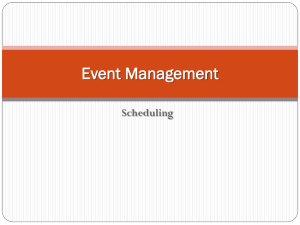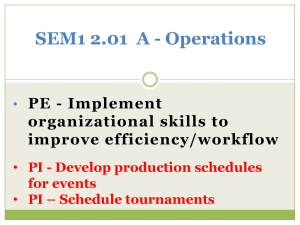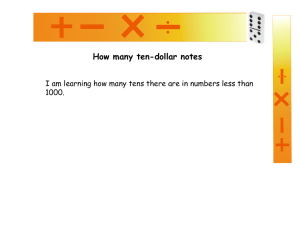Event Management
advertisement

Event Management Scheduling Types of Tournaments 1. 2. 3. 4. 5. 6. Single Elimination Consolation Double Elimination Round Robin Challenge Tournaments Season Seeding Seeding is placing rankings on each entry. The purpose is to prevent highly skilled entries from eliminating one another in the early rounds, in the hopes that the top contenders meet in the final rounds and the top two entries compete for the championship When seeding 8 entries or less, follow this method: top of the top, bottom of the bottom, top of the bottom, bottom of the top (then reverse if 9 entries or more, up to 16) Byes First Round ONLY The highest seed(s) in the tournament should receive the bye(s). When the total number of entries does not work out to an even power of 2 (2,4,8,16,etc) byes must be used. Take the nearest power of 2 and subtract the number of entries to find out the number of byes needed. Example: 6 entries 8 – 6 = 2 byes Which Type Do I Use? Which type of tournament to set up depends on several factors. Number of entries Time allotted for playing the tournament Facilities available The advantages and disadvantages of each type of tournament. Single Elimination Advantage – quickest method of determining a winner. Disadvantage – provides the fewest opportunities for contestants to play. The total number of games to be played can be figured by subtracting 1 from the number of entries. Example: 16 entries 16 – 1 = 15 games Single Elimination To determine the number of rounds, the total should be the same number as the power to which 2 must be raised to equal the number of entries. Example: For 8 entries, 2 must be raised 3 times (2X2X2)=8. A tournament with 8 entries would then have 3 rounds. Consolation Tournament A consolation tournament may be conducted with losers from the first round of a single elimination tournament. Allows for every entry to play at least 2 games and follows the same format as a single elimination tournament. Double Elimination Advantage – includes a minimum of 2 games for each entry and a shortened game schedule. Disadvantage – is that participation is reduced by having a limit of 2 losses. Double elimination tournaments operate in the same manner as a single elimination tournament with one major exception. Entries must lose 2 games to be eliminated. Once an entry loses it then goes to the losers bracket to continue play. The teams that win out in both brackets are matched for the Championship. The max number of games to be played can be figured by the following formula: 2(N-1)+1= E.g. 16 teams, 2(16-1)+1= 31 possible games Double Elimination Round Robin Tournament Advantage – provides an equal number of games for all teams. Disadvantage – it takes a great deal of time to complete if there are several teams competing. A round robin tournament provides the opportunity for a number of teams in a tournament to play against one another: once (single round robin), twice (double round robin), etc… To determine the number of rounds to be played, follow this formula: Odd number of teams = N Even number of teams = N-1 e.g. 5 teams = 5 rounds e.g. 6 teams: 6 – 1 = 5 rounds Round Robin Tournament To determine the number of games to be played: No. of games = N (N-1) 2 e.g. 6 teams, 6 (6-1) = 15 games 2 To determine the complete schedule, for an even number of entries, leave one team in a constant location and rotate the others counterclockwise. Rounds 1 2 3 4 5 A–F A–E A–D A–C A–B B–E F–D E–C D–B C–F C–D B–C F–B E–F D–E Round Robin Tournament For an odd number of entries leave the bye in a constant location and rotate the others counterclockwise. Rounds 1 2 3 4 5 Bye – E Bye – D Bye – C Bye – B Bye – A A–D E–C D–B C –A B–E B–C A–B E –A D–E C–D Wins, losses and ties can be recorded on a chart like the following: Teams A B C D E A B C D E Total Points Challenge Tournaments Their purpose is to encourage participants to challenge one another, and if successful, to move ahead on a ladder of pyramid. Advantage – can establish ability levels in preparation for other types of tournaments. Disadvantage – after the initial play and changing of positions, the number of challenges usually decreases, leading to fewer games for all participants. Challenge Tournaments Ladder Tournament Players are placed on a ladder randomly or are seeded. Sometimes placing higher seeds near the bottom encourages more movement/games. Players advance by defeating players 1 or 2 places higher on the ladder. Higher players must accept a challenge from a lower player. If the challenger wins, they exchange places on the ladder. Losers of the match cannot challenge for a rematch until they have played at least one other opponent. Challenge Tournaments Pyramid Tournament Similar to a ladder tournament with 1 important difference:You must win at least 1 game on your row before challenging a player on a higher row. Ranks players by ability and players are able to play players of equal ability. Promotes a high number of games and equal competition. Season/League When setting up a season or league schedule you have several factors to consider. 1. Consider the needs and interests of participants: a. b. Competitive or non-competitive? Should the activity be modified to meet their physical needs? Determine Numbers: 2. a. How many registered, what are your maximum and minimum numbers that you can go with? Consider Time: 3. a. b. c. d. e. How many days/weeks are needed? How long should the league run for? Game length? Playoff Structure? What days/times should be avoided? Season/League Consult with people in charge of facilities and equipment: 4. a. b. c. Consult with person in charge of personnel: 5. a. b. c. 6. What type of equipment/facilities are needed? When is the equipment/facilities available? Who will set up and take down equipment if needed? How many refs/scorers/and other officials are needed? When and where will they be needed? Who contacts them in case of cancellations? Develop your schedule








